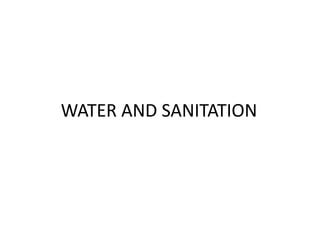
Water and sanitation
- 2. SCENARIO • Water supply and sanitation in India, especially in rural india continue to be inadequate • The level of investment in water and sanitation is low • Also, the local government institutions in charge of operating and maintaining the infrastructure are seen as weak and lack the financial resources to carry out their functions In 2008, Access to improved water supply-84% Access to Improved sanitation-21% which was only 1% in the year 1980
- 3. Responsibility for water supply and sanitation • Water supply and sanitation is a State responsibility under the Indian Constitution. States may give the responsibility to the Panchayati Raj Institutions (PRI) in rural areas. • At present, states generally plan, design and execute water supply schemes (and often operate them) through their State Departments of Rural Development Engineering) • The Ministry of Drinking Water and Sanitation is responsible for the regulation and the policy framework for rural water supply and sanitation.
- 4. SERVICE PROVISION • About a 100,000 rural water supply systems in India • In some states responsibility for service provision is in the process of being partially transferred from State Water Boards and district governments to Panchayati Raj Institutions (PRI) at the block or village level • Service provision more advanced for single-village water schemes than for more complex multi-village water schemes
- 5. APPROACHES IN RURAL SANITATION • Total Sanitation Campaign (TSC) or Nirmal Bharat Abhiyan (NBA) initiated by Government of India in 1999 • It is a demand-driven and people-centered sanitation program • The main goal of Total Sanitation Campaign is to eradicate the practice of open defecation by 2017. • Community-led total sanitation is not focused on building infrastructure, but on preventing open defecation through peer pressure and shame. • In Maharashtra where the program started more than 2000 Gram Panchayats have achieved "open defecation free" status • Villages that achieve this status receive monetary rewards
- 6. APPROACHES IN RURAL WATER SUPPLY • Most rural water supply schemes in India use a centralised approach, i.e. a government institution designs a project with little community consultation and no capacity building for the community, no water fees to be paid for its subsequent operation. • In 2002 , Government of India came up with a national level a program to change the way in which water supply services are supported in rural areas. • Swajaldhara decentralizes service delivery responsibility to rural local governments and user groups. Communities are being consulted and trained, and users agree to pay a tariff that is set at a level sufficiently high to cover operation and maintenance costs. It also includes measures to promote sanitation and to improve hygiene behaviour.
- 7. COST ANALYSIS:SWAJALDHARA • According to a 2008 World Bank study in lower capital costs, lower administrative costs and better service quality compared to the centralised approach. • The average full cost of supply-driven schemes is Rs. 38 per cubic meter, while it is only 26 per cubic meter for demand-driven schemes. • As of 2008 only about 10% of rural water schemes built in India used a demand-driven approach. Since water users have to pay lower or no tariffs under the supply-driven approach, this discourages them to opt for a demand-driven approach, even if the likelihood of the systems operating on a sustainable basis is higher under a demand-driven approach.
- 8. TARIFF AND COST RECOVERY • Low Water and sewer tariffs in India and low cost recovery • Some state governments subsidise rural water systems, but funds are scarce and insufficient. • On one hand, expenditures are high due to high salary levels, high power tariff and a high number of operating staff. On the other hand, revenue is paid only by the 10% of the households who have private connections. • Those drawing water from public stand posts do not pay any water charges at all, although the official tariff for public stand post users is 15 per month per household
- 9. World Bank Financing • The World Bank finances a number of projects in rural areas fully or partly dedicated to water supply and sanitation. • The Andhra Pradesh Rural Water Supply and Sanitation (US$150 million loan, approved in 2009) • The Karnataka Rural Water Supply and Sanitation Project (approved in 2001, US$151.6 million loan) • The Uttaranchal Rural Water Supply and Sanitation Project (approved in 2006, US$120 million loan) • The Punjab Rural Water Supply and Sanitation Project (approved in 2006, US$154 million loan)
